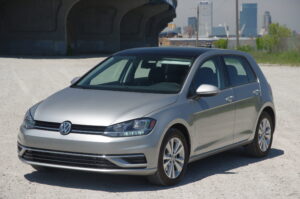
For 2020, VWoA lobbed branches from its sluggish-selling Golf family tree. It axed wagons and SE hatchbacks. The non-GTI Golf dons one “value” trim dubbed “S.” You get keyless entry, pushbutton start, sunroof, blind spot detection, 16-inch alloy wheels, leatherette upholstery, heated front seats and forward collision warning.
Golf’s powertrain has an alloy-block 147-hp 1.4-liter turbo four cylinder mill, saddled with either a six-speed manual or an eight-speed automatic. Car and Driver claims the manual Golf is a sleeper in the worst sense of that word.
Because of C/D’s rules of (dis)engagement—you cannot downshift and use third for passing—it’s lazy. Select third and the car pulls briskly from 25 mph to 70 mpg. The automatic Golf is considerably quicker as C/d lets automatics downshift.
VW’s Golf/Rabbit became the brand’s signature model during the mid-1970s amid a corporate dash to lop off its elderly Bug. The front-drive, transverse water-cooled engine Golf was antithetical to everything VW until then. It was roomy, swift, stable and competitive—except in price. VW tried fixing the price problem by building it in the USA. It added a truck and GTI to the line. There was a moment when the diesel Rabbit popular.
I mention the latter because the latest, much larger Golf’s fuel economy is quite good. I got 38.5 mpg overall. You can easily best 40 mpg on the highway.
Although the Golf is a great package, my tester’s rear seat latch rattled, rear-view mirror squeaked and clutch pedal unleashed a gaggle of honking geese.
The Golf’s interior is above average. The wrap-around padded dash and driver-canted cockpit seem upscale. Euro-sleek thumbwheels control vents. Everything fits with businesslike acumen. But the buried USB-C slot is difficult to use. In contrast, VW lined door cubbies and the lighted glovebox’s innards. Alas, the decor degrades in the aft compartment. But you do get a split-fold rear seat with pass through.
A stout two-level load floor with nifty side tabs so you can prop it up while extracting tools or the spare tire is thoughtful.
Those in front get power-recline bucket seats with manual height and lumbar. And there’s an adjustable center armrest. Analogue-style instrumentation is lucid. The instrument cluster’s trip-computer calculates fuel consumption prompts you when to shift.
The Golf rolls on 16-inch Bridgestone Ecopia low-rolling resistance tires. They howl, when cornering. Ride comfort is good. Directional stability is fine. Low-beam headlight performance fair.
Motoring in the Golf reveals an unobtrusive power train. I noticed a few spots, though, where vibration intruded. The most salient thing is the gear ratios. They’re for limbo-low engine rpm. According to Volks, max torque hits at 1,600 rpm and peaks at 3,500 rpm.
Winding the springy shift lever through the gears is easy; VW feathers rpm for you as you release the clutch pedal. Plus there’s a hill-hold brake function. There’s a rub or two: the parking brake lever is stiff; ahead of it is a sharp edge. You’ll find silky smooth climate controls. The automatic wiper stalk markings are intuitive. The Golf is Android Auto and Apple Carplay friendly.
VW asks $24,114 for the Tungsten silver metallic over black leatherette interior. That’s not cheap. Yet, the vehicle motors with greater finesse than, say, Hyundai’s Venue Denim which feels cheap. For quick relief, use third.
